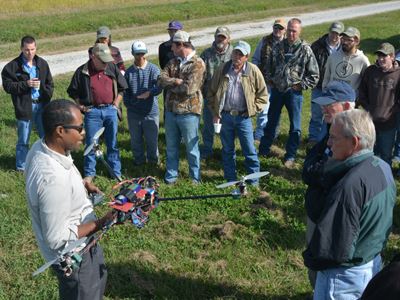AgCenter Researchers Study Use Of Drones In Crop Monitoring
BATON ROUGE, LA.
LSU AgCenter researchers are trying to determine if using unmanned
aerial vehicles, sometimes known as drones, can help farmers monitor
their crops for potential problems.
“We are investigating the use of UAVs to see what the capabilities
are,” said Randy Price, LSU AgCenter engineer. “From what we can tell,
the technology appears to be promising.”
Price said a UAV was used recently to check on freeze damage in a
sugarcane field by taking photographs that could be viewed once the
vehicle returned to the ground.
Price said one of the first projects involves sending up a UAV
equipped with a sensor to measure the vegetative index of a crop. The
device measures the green growth of a plant, giving a possible
indication if additional fertilizer is needed on specific areas of a
field.
Jimmy Flanagan, LSU AgCenter county agent in St. Mary Parish, is
learning to use a helicopter UAV to fly over sugarcane fields to
determine if adequate fertilizer has been applied across a field.
Flanagan said he learned about UAVs in agriculture when he attended a
county agent meeting last year in Nebraska. He said the aircraft will
be useful in maturing fields of sugarcane and corn where it is difficult
to scout tall crops for disease and insufficient fertilizer.
Flanagan said some of the UAVs are small helicopters with three or
four rotors. Radio-controlled airplanes are available, too. “The copter
is good for certain things, but the fixed wing is faster for covering
larger acreage.”
Price said Charles Malveaux, an LSU AgCenter research associate, has
built three UAVs capable of flying themselves on a programmed mission.
“We’re in the process of building two more right now.”

Charles Malveaux, LSU AgCenter
research associate, at left, explains the capabilities of an unmanned
aerial vehicle to personnel at the Rice Research Station. The devices
have the potential to aid farmers and crop consultants by scouting
fields for pests, and LSU AgCenter researchers are investigating other
possible uses for the aircraft.
Photo by Bruce Schultz
Price said the Federal Aviation Administration is writing regulations
for UAVs and drones to prevent interfering with manned aircraft,
including agricultural airplanes and helicopters. The unmanned devices
are still classified as hobby aircraft not available for commercial use,
he said, but new regulations will address commercial applications.
Flanagan said the LSU AgCenter is applying for a special FAA permit
to conduct further research and the eventual publication of a research
paper.
Price said entomologists will be able to use the pilotless vehicles
to scout for insects, and weed scientists will be able to quickly view a
field for herbicide-resistant weeds.
Eric Webster, LSU AgCenter weed scientist, said UAVs might be helpful
for farmers to spray swaths in a field not sprayed with herbicides by
conventional aerial applicators.
Steve Linscombe, director of the LSU AgCenter Rice Research Station,
said the battery-powered aircraft might be useful in rice breeding.
“We think that they might be useful in creating wind movement that
might facilitate the transfer of pollen from restorer lines to male
sterile lines to create the F1 seed,” he said.∆